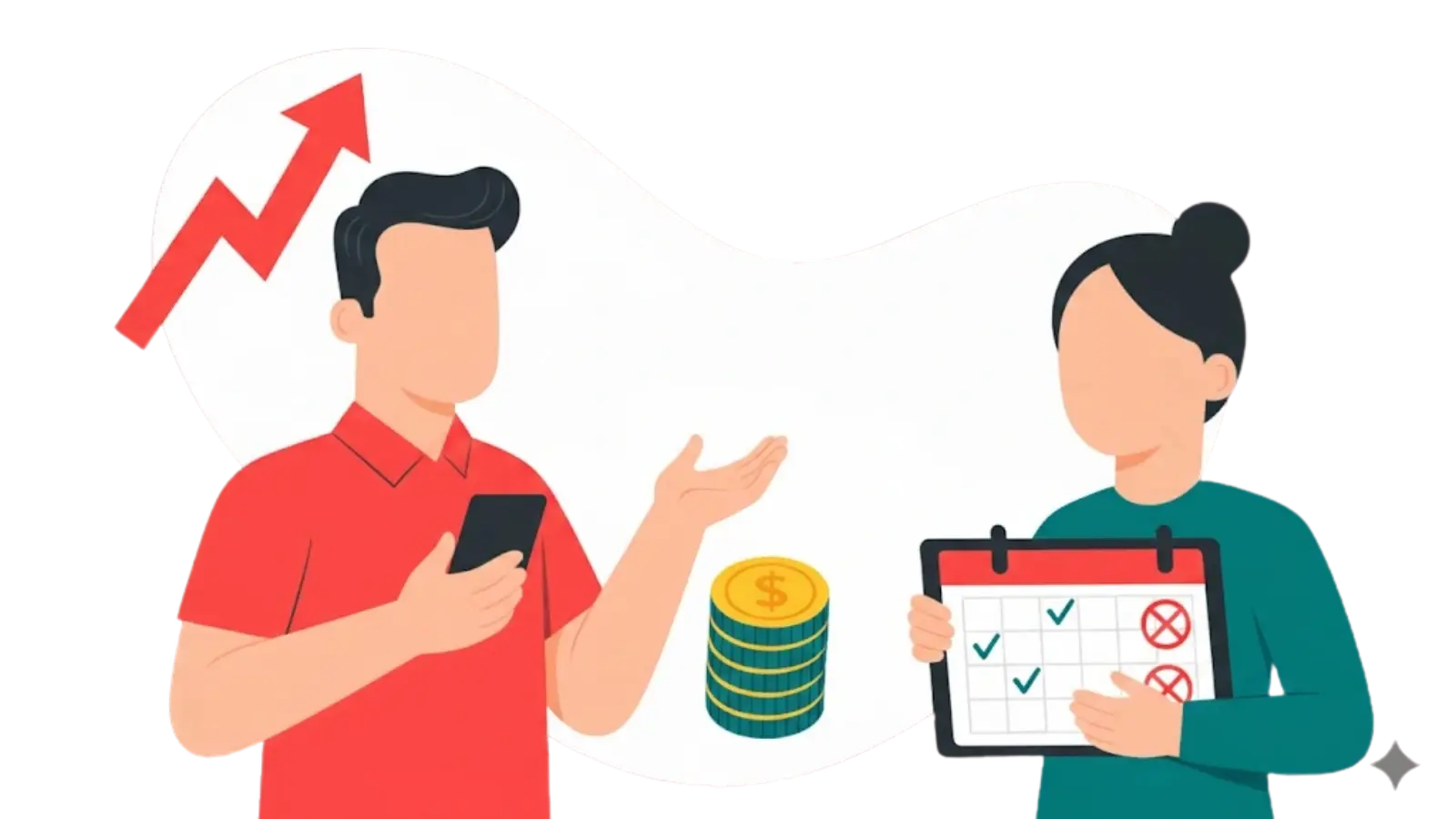Updated : Nov 18, 2025
Booking.com’s commission structure and cancellation policies can significantly impact your property’s profitability, but the right pricing software can help you navigate these challenges strategically. With Booking.com charging commissions of 10-25% depending on your property type and location, optimizing your pricing strategy is crucial to maintaining healthy margins.
Modern pricing software, like PriceLabs, doesn’t just automate rate adjustments—it provides sophisticated tools to minimize the financial impact of cancellations while maximizing your revenue potential.
By implementing data-driven pricing strategies, you can offset commission costs, reduce cancellation losses, and improve your overall booking performance on the platform.
Understanding Booking.com’s Fee Structure
Booking.com uses a commission-based model, meaning you pay a percentage of each confirmed reservation. The exact commission depends on your property type, location, and booking volume:
- Hotels: typically 15–20%
- Vacation rentals & apartments: usually 10–15%
Beyond standard commissions, hosts may choose additional paid options:
- Premium placement & ads: extra fees for better visibility
- Genius program: reduces your commission by 1–3%, but you must offer 10%+ discounts to eligible guests
Your commission directly lowers your actual earnings. For example, with a $200 nightly rate and an 18% commission, your revenue drops to $164 per night before expenses. This makes strategic pricing essential to protect profitability and ensure you’re not leaving money on the table.
How Pricing Software Addresses Booking.com Challenges
Modern pricing software addresses Booking.com’s fee structure by using sophisticated algorithms that factor commission costs directly into rate calculations. Rather than setting rates and hoping for profitability, these tools automatically adjust your pricing to ensure you meet your net revenue targets after commissions.
Advanced pricing platforms, like PriceLabs, analyze competitor rates on Booking.com specifically, not just across all channels. This channel-specific intelligence helps you price competitively while accounting for the platform’s unique fee structure. The software can also identify optimal pricing windows when demand is high enough to support higher rates that offset commission costs.
Integration capabilities allow pricing software to sync directly with Booking.com’s extranet, enabling real-time rate updates based on market conditions, occupancy levels, and revenue goals. This automation ensures you’re always pricing optimally without manual intervention.
Strategy 1: Dynamic Commission-Adjusted Pricing
Dynamic commission-adjusted pricing ensures Booking.com’s fees are never an afterthought. Instead of setting a $200 nightly rate and losing $36 to commissions, the software works backwards to calculate the exact gross price you need—in this case, roughly $244—to still earn your target $200 net revenue.

This strategy starts by defining your desired net revenue per night. The software then reverse-engineers the right gross price by factoring in:
- your current commission rate
- Booking.com’s performance-based commission changes
- property-specific metrics that may influence your rate
Because Booking.com commissions aren’t always static, the software continuously monitors and adjusts your rates to stay aligned with your revenue goals.
More advanced versions of this strategy also account for seasonal commission shifts and promotional periods where Booking.com temporarily reduces fees for eligible properties. By anticipating these variations and adjusting in real time, you maintain steady profitability across both high and low seasons.
Dynamically Price Your Property and Get FREE Custom Reports Tailored To Your Property!
Use PriceLabs Dynamic Pricing to competitively and dynamically price your property according to demand shifts and analyze past performance to set a strong pricing strategy for your property.
Create your Account NowStrategy 2: Cancellation-Aware Rate Optimization
Cancellation-aware pricing helps you protect your revenue by adjusting your rates based on real cancellation behaviour—not guesswork. Properties that use this strategy often see 15–20% improvements in net revenue, simply by pricing smarter around cancellation risk.
The software examines your historical data to uncover patterns, such as:
- higher cancellation rates for long lead-time bookings
- seasonal spikes in last-minute cancellations
- specific stay lengths or guest segments with higher risk
With these insights, it automatically raises rates for booking patterns that carry a higher likelihood of cancellation, ensuring you’re compensated for potential revenue loss.

This approach is especially valuable on Booking.com, where free cancellation options often boost your visibility and rankings. By pricing with cancellation risk built in, you can offer these guest-friendly policies without sacrificing your profitability.
Strategy 3: Competitive Rate Intelligence
Competitive rate intelligence gives you a real-time view of how your competitors price themselves on Booking.com—and how their strategies stack up once commissions are factored in. Instead of just tracking nightly rates, these tools analyze how competitors position their pricing relative to Booking.com’s fee structure, giving you a clearer picture of true market behaviour.

With this visibility, the software can identify:
- Competitors underpricing unintentionally because they didn’t account for commission costs—creating opportunities for you to win bookings at profitable rates
- Moments when competitors raise prices, signalling stronger demand and safe windows for you to increase your rates
- Price gaps in your market where you can adjust to capture more bookings while preserving your margins
More advanced intelligence even evaluates competitor occupancy trends and booking velocity, helping you understand when:
- it’s safe to push rates higher, or
- you need to adjust to shifting demand
This real-time pulse on your competitive landscape is essential for staying profitable on Booking.com’s high-stakes, fast-moving marketplace.
Strategy 4: Length of Stay and Lead Time Optimization
Length of stay (LOS) and lead time optimization help you fine-tune your pricing by understanding how booking duration and advance booking windows impact both revenue and cancellation risk. Longer stays usually have lower cancellation rates, which means you can price them more competitively while still maintaining strong net revenue after Booking.com’s commissions.

The software analyses your historical booking patterns to determine the most profitable pricing strategies for different stay lengths. For example, you might introduce better nightly rates for 7-night or 14-night stays, knowing these bookings bring higher stability, lower operational workload, and more predictable cash flow.
Lead time optimization adds another layer of intelligence. It examines when guests typically book—30, 60, or 90+ days in advance—and adjusts your pricing accordingly.
- Long lead times may carry higher cancellation risk, but also signal strong demand.
- Shorter lead times may show lower cancellation risk but require more competitive pricing to drive occupancy.
By combining LOS and lead time insights, the software ensures you’re always balancing demand patterns, cancellation behaviour, and Booking.com’s commission impact to maximise net revenue.
Strategy 5: Automated Inventory and Rate Management
Automated inventory management ensures your availability and pricing stay aligned across all channels while accounting for Booking.com’s commission-heavy model. This helps prevent rate disparities, protects you from parity violations, and ensures each booking is profitable.
How it works:
- Syncs room availability across all connected channels in real time
- Adjusts Booking.com inventory based on occupancy goals and channel performance
- Maintains rate parity while optimizing for each platform’s fee structure
Revenue impact:
- Reduces overbookings and manual errors
- Prioritizes higher-margin channels (like direct bookings) when they perform well
- Expands Booking.com availability only when demand justifies the commission
Rate synchronization ensures every price update—whether market-driven or strategy-driven—is reflected instantly across all distribution channels, keeping you compliant while maximizing revenue potential.
Strategy 6: Seasonal and Event-Based Adjustments
Booking.com performance fluctuates throughout the year, making seasonal and event-based pricing essential. These strategies help you capture peak-season revenue and stay competitive during slower periods.
Seasonal optimization includes:
- Higher rates during periods when demand outweighs competition
- More competitive pricing during shoulder and off-peak seasons
- Commission-adjusted pricing that ensures profitability year-round
Event-based adjustments help you:
- Automatically raise rates during conferences, festivals, concerts, or local events
- Capture premium demand from Booking.com’s high-traffic windows
- Use historical and real-time market data to identify profitable opportunities
These strategies also consider Booking.com’s promotional calendar, helping you:
- Align with platform-wide sales when beneficial
- Avoid discounting during times that may reduce your visibility or margins
Strategy 7: Performance Analytics and Continuous Optimization
Performance analytics reveal the true profitability of Booking.com after accounting for commissions, cancellations, and operational expenses. This data gives you clarity on whether your strategy is working—and what needs refinement.
Key metrics include:
- NetRevPAR specific to Booking.com reservations
- Cancellation rates by booking source and lead time
- Commission costs as a percentage of total revenue
- Booking velocity and occupancy contribution
Using these insights, continuous optimization algorithms fine-tune your strategy over time.
What continuous optimization does:
- Learns from booking patterns, seasonality, and pacing
- Adjusts pricing in real time based on performance and market shifts
- Tailors rate recommendations to your property’s unique behaviour
This ensures your Booking.com strategy evolves dynamically, keeping your pricing competitive, data-driven, and consistently profitable.
Measuring Success and ROI
Success measurement for Booking.com optimization focuses on net revenue growth rather than just booking volume or average daily rates. Properties implementing comprehensive pricing software strategies, such as those offered by PriceLabs, typically see 12-18% improvement in net revenue from Booking.com within the first six months.
Key metrics to track include total commission costs as a percentage of revenue, cancellation loss rates, and booking conversion rates at different price points. Comparing these metrics before and after implementing pricing software provides clear ROI calculations.
Long-term success also depends on maintaining strong performance scores on Booking.com while optimizing pricing. The platform’s algorithm favors properties with high guest satisfaction scores and low cancellation rates, creating a virtuous cycle in which optimized pricing supports better platform performance, which in turn supports higher occupancy and rates.









